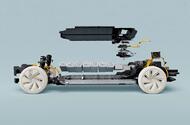Volvo partners with battery firm to create adaptive tech that controls range-improving battery conditions in real time
However appealing the oily stuff may be to anyone with even slight petrolhead leanings, the fact is that software is becoming hugely important in shaping the character of our cars.
That applies to not just the way they are designed and put together but also the way they work.
It’s not all about things like ADAS, autonomous driving and snatching the joy away from the driver, though. There are areas where using advanced software will actually bring a tangible improvement to the ownership experience.
One example is the clever use of software algorithms to squeeze significantly more range from electric cars. Volvo has teamed up with Breathe Battery Technologies and become the first car maker to use the firm’s Breathe Charge, which takes a different approach to feeding power to the battery to speed up charging.
Volvo says it expects Breathe Charge will reduce the time taken to rapid charge its new-generation EVs from 10% to 80% by as much as nearly a third. That does depend on the type of battery pack, says Volvo, and tests have indicated improvements of between 15% and 30%. Whatever the case, the improvement is significant compared with existing charging techniques.
Whereas traditional charging is stepped in a way that is based on a set of rules, Breathe’s software takes an adaptive approach to control the battery in real-time without posing any threat to an individual battery’s wellbeing. The algorithms it uses take account of battery health in real time to avoid the risk of battery charging through lithium plating of the battery’s negative electrodes (anodes).
What should happen during charging is that lithium ions insert themselves into the anode material, which is usually graphite-based in a lithium ion battery.
During discharge, they are released by the anodes and absorbed by the cathodes (positive electrodes). The process alternates as the battery is charged and discharged.
If too much power is used during charging or if the temperature is too low for the power being used, lithium ions can form a metal plating on the surface of the anodes, reducing battery capacity and increasing internal electrical resistance. This impacts the performance of an EV and, perhaps worst of all, accelerates the battery ageing process.
An even less appealing spin-off from lithium plating is the formation of dendrites, which resemble the roots of a plant. Dendrites can grow and ultimately penetrate the separator between the anode and cathode, spelling doom for the battery.
Being able to apply intelligent software to the charging process means batteries can be safely charged as fast as possible without the process becoming a guessing game.
Software has always been important in high-voltage lithium ion batteries, which all have integral battery management systems. But as research continues, the use of software could become at least as important in battery development as the evolution of battery chemistry.

